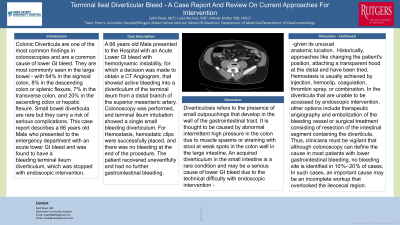Back


Poster Session D - Tuesday Morning
Category: GI Bleeding
D0318 - Terminal Ileal Diverticular Bleed: A Case Report and Review on Current Approaches for Intervention
Tuesday, October 25, 2022
10:00 AM – 12:00 PM ET
Location: Crown Ballroom

Has Audio

Sahil Raval, MD
Saint Peter's University Hospital
New Brunswick, NJ
Presenting Author(s)
Sahil Raval, MD1, Luisa Recinos, MD1, Arkady Broder, MD, FACG2
1Saint Peter's University Hospital, New Brunswick, NJ; 2Rutgers Medical School of Robert Wood Johnson, Saint Peter's University Hospital, New Brunswick, NJ
Introduction: Colonic Diverticula are one of the most common findings in colonoscopies and are a common cause of lower GI bleed. They are most commonly seen in the large bowel - with 64% in the sigmoid colon, 8% in the descending colon or splenic flexure, 7% in the transverse colon, and 20% in the ascending colon or hepatic flexure. Small bowel diverticula are rare but they carry a risk of serious complications. This case report describes a 66 years old Male who presented to the emergency department with an acute lower GI bleed and was found to have a bleeding terminal ileum diverticulum, which was stopped with endoscopic intervention.
Case Description/Methods: A 66 years old Male presented to the Hospital with an Acute Lower GI bleed with hemodynamic instability, for which a decision was made to obtain a CT Angiogram, that showed active bleeding into a diverticulum of the terminal ileum from a distal branch of the superior mesenteric artery. Colonoscopy was performed, and terminal ileum intubation showed a single small bleeding diverticulum. For Hemostasis, hemostatic clips were successfully placed, and there was no bleeding at the end of the procedure. The patient recovered uneventfully and had no further gastrointestinal bleeding.
Discussion: Diverticulosis refers to the presence of small outpouchings that develop in the wall of the gastrointestinal tract. It is thought to be caused by abnormal intermittent high pressure in the colon due to muscle spasms or straining with stool at weak spots in the colon wall in the large intestine. An acquired diverticulum in the small intestine is a rare condition and may be a serious cause of lower GI bleed due to the technical difficulty with endoscopic intervention given its unusual anatomic location. Historically, approaches like changing the patient's position, attaching a transparent hood at the distal end have been tried. Hemostasis is usually achieved by injection, hemoclip, coagulation, thrombin spray, or combination. In the diverticula that are unable to be accessed by endoscopic intervention, other options include therapeutic angiography and embolization of the bleeding vessel or surgical treatment consisting of resection of the intestinal segment containing the diverticula. Thus, clinicians must be vigilant that although colonoscopy can define the cause in most patients with lower gastrointestinal bleeding, no bleeding site is identified in 10 %– 20 % of cases. In such cases, an important cause may be an incomplete workup that overlooked the ileocecal region.

Disclosures:
Sahil Raval, MD1, Luisa Recinos, MD1, Arkady Broder, MD, FACG2. D0318 - Terminal Ileal Diverticular Bleed: A Case Report and Review on Current Approaches for Intervention, ACG 2022 Annual Scientific Meeting Abstracts. Charlotte, NC: American College of Gastroenterology.
1Saint Peter's University Hospital, New Brunswick, NJ; 2Rutgers Medical School of Robert Wood Johnson, Saint Peter's University Hospital, New Brunswick, NJ
Introduction: Colonic Diverticula are one of the most common findings in colonoscopies and are a common cause of lower GI bleed. They are most commonly seen in the large bowel - with 64% in the sigmoid colon, 8% in the descending colon or splenic flexure, 7% in the transverse colon, and 20% in the ascending colon or hepatic flexure. Small bowel diverticula are rare but they carry a risk of serious complications. This case report describes a 66 years old Male who presented to the emergency department with an acute lower GI bleed and was found to have a bleeding terminal ileum diverticulum, which was stopped with endoscopic intervention.
Case Description/Methods: A 66 years old Male presented to the Hospital with an Acute Lower GI bleed with hemodynamic instability, for which a decision was made to obtain a CT Angiogram, that showed active bleeding into a diverticulum of the terminal ileum from a distal branch of the superior mesenteric artery. Colonoscopy was performed, and terminal ileum intubation showed a single small bleeding diverticulum. For Hemostasis, hemostatic clips were successfully placed, and there was no bleeding at the end of the procedure. The patient recovered uneventfully and had no further gastrointestinal bleeding.
Discussion: Diverticulosis refers to the presence of small outpouchings that develop in the wall of the gastrointestinal tract. It is thought to be caused by abnormal intermittent high pressure in the colon due to muscle spasms or straining with stool at weak spots in the colon wall in the large intestine. An acquired diverticulum in the small intestine is a rare condition and may be a serious cause of lower GI bleed due to the technical difficulty with endoscopic intervention given its unusual anatomic location. Historically, approaches like changing the patient's position, attaching a transparent hood at the distal end have been tried. Hemostasis is usually achieved by injection, hemoclip, coagulation, thrombin spray, or combination. In the diverticula that are unable to be accessed by endoscopic intervention, other options include therapeutic angiography and embolization of the bleeding vessel or surgical treatment consisting of resection of the intestinal segment containing the diverticula. Thus, clinicians must be vigilant that although colonoscopy can define the cause in most patients with lower gastrointestinal bleeding, no bleeding site is identified in 10 %– 20 % of cases. In such cases, an important cause may be an incomplete workup that overlooked the ileocecal region.

Figure: Active Hemorrhage into a Diverticulum of the Terminal Ileum
Disclosures:
Sahil Raval indicated no relevant financial relationships.
Luisa Recinos indicated no relevant financial relationships.
Arkady Broder: GITrak – Advisory Committee/Board Member.
Sahil Raval, MD1, Luisa Recinos, MD1, Arkady Broder, MD, FACG2. D0318 - Terminal Ileal Diverticular Bleed: A Case Report and Review on Current Approaches for Intervention, ACG 2022 Annual Scientific Meeting Abstracts. Charlotte, NC: American College of Gastroenterology.
